Trichomes, Terpenes & Terpenoids: Guide to What They Are and Their Uses
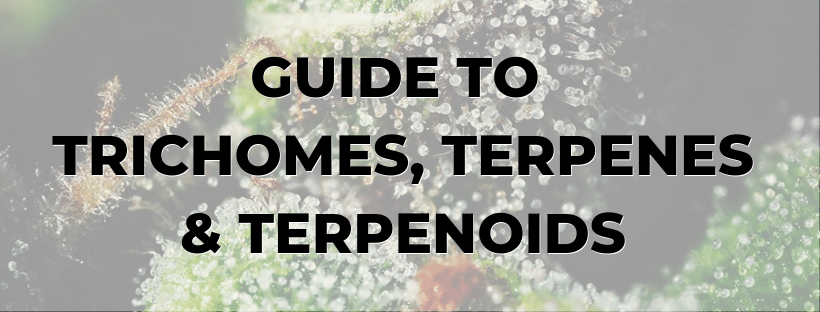
Introduction to Trichomes, Terpenes, and Terpenoids
Every human body is built with an Endocannabinoid System (ECS), which manages our biological functions such as fertility, pain, appetite, mood, and memory.
The ECS functions as a lock and key system, and when cannabinoids (the keys) are ingested, they interact with cannabinoid receptors (or locks) that naturally occur in the body.
This ingestion contributes to the psychological and physiological effects typically associated with cannabis, both in THC and CBD. Terpenes, terpenoids, and trichomes are not as well known compared to cannabinoids.
Terpenes and terpenoids are essentially the same things, and the two terms are often used interchangeably. A terpene is a naturally occurring hydrocarbon, while terpenoids are compounds related to terpenes, which may include some oxygen rearrangement.
Trichomes are growths of hair that can be found on a multitude of different plants. On cannabis plants, they often look similar to mushrooms. They are the source of the flavor and aroma that help us differentiate between our favorite strains of cannabis.
This terpene guide will help you understand the difference between these different kinds of compounds, how they affect the taste, flavor, and strength of cannabis. You also get an in-depth lesson on what terpenes can be used for and how they can be ingested and administered.
Trichomes
What are Trichomes?
Trichomes are tiny hairs that emerge from the surface of the buds, stalks, stems, and leaves of the cannabis plant and surprisingly many other plants from the algae and fungi family. Trichomes are comprised primarily of a stalk and a head. The production of THC, CBD, and other medicinal cannabinoids are created within the head of the trichome.
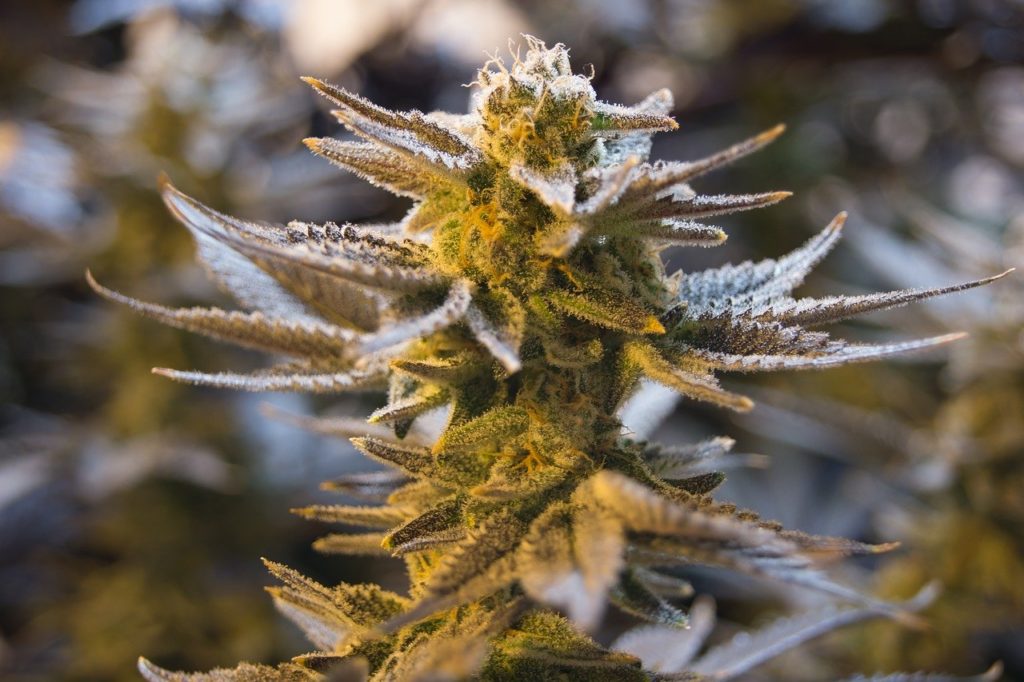
However, the trichome is also able to perform an array of functions that help to ensure a plant is able to make it to full maturity.
Trichome Functions
Trichomes serve a wide variety of functions. Trichomes resemble microscopic hairs covered in crystals, so it makes sense that the word “trichome” comes from the Greek word trichoma, which translates to “hairs.”
Trichomes create the sticky resin that binds to your fingers when you handle top-shelf marijuana. These powerful tiny hairs defend the plant from environmental threats and house mini-production facilities that are responsible for producing the active ingredients in cannabis.
With this said, trichomes are not something you can go out buy, smoke and enjoy. At their core, trichomes perform an important duty that helps the overall well-being of the plant besides getting you high.
Perhaps one of the most unexpected abilities of the trichome is that it is able to serve as a deterrent for wild animals. The fibers contain a bitter taste that creates the assumption the plant might be toxic or otherwise inedible.
By ensuring that animals will not want to consume the cannabis plant, the trichome gives the plant a much better yielding more and increasing their chance of reaching full maturity.
The disparity between overall bud quality and the presence of trichomes comes from the other variables that impact plant growth, (wind, UV ray exposure, so on and so forth).
If you were able to get your hand on some original OG Kush, OG stands for Ocean Grown, you notice that these buds will be stacked with trichome production.
Why? Because ocean grown marijuana has to protect itself from the higher amounts of sea salt in the air. The plant reacts by producing more trichomes, creating a potent, sticky frosty bud.
So when you see buds stacked with trichomes you will know you are in for a treat and now know why they are there.
Types of Trichomes

There are 3 kinds of trichomes: Capitate Sessile Trichomes, Capitate-Stalked Trichomes, and Bulbous Trichomes.
Trichomes play some of the cannabis plant’s most essential functions, but what role trichomes play depends on what type of trichome they are and where they’re located… for example, root hairs and leaf hairs of trichomes absorb nutrients, including minerals and water.
Leaf hairs also serve the purpose of lowering plant temperature and protecting against harmful UV rays and loss of hydration.
Here’s a breakdown of the different types of trichomes and what they do.
Bulbous trichomes
Bulbous trichomes are the smaller orbs that are found all across the plant. They consist of very few cells and aren’t as impactful as the two other types but their presence is nevertheless felt on the cannabis plant.
Capitate sessile trichomes
Capitate sessile trichomes are the more moderate of the three varieties. They are substantially bigger than the bulbous trichome and are generally found around the head of the plant.
Capitate-stalked trichome
The capitate stalked trichome is what most people think of when trichomes on leaves of the cannabis plant come to mind. They are waxy and fibrous and large, visible by the naked eye.
You can see them, touch them, interact with them.
Though all three classifications of trichomes are able to produce cannabinoids it’s the capitate stalked variety that are best for the harvesting of oils.
Trichome Stages, Color and Harvest
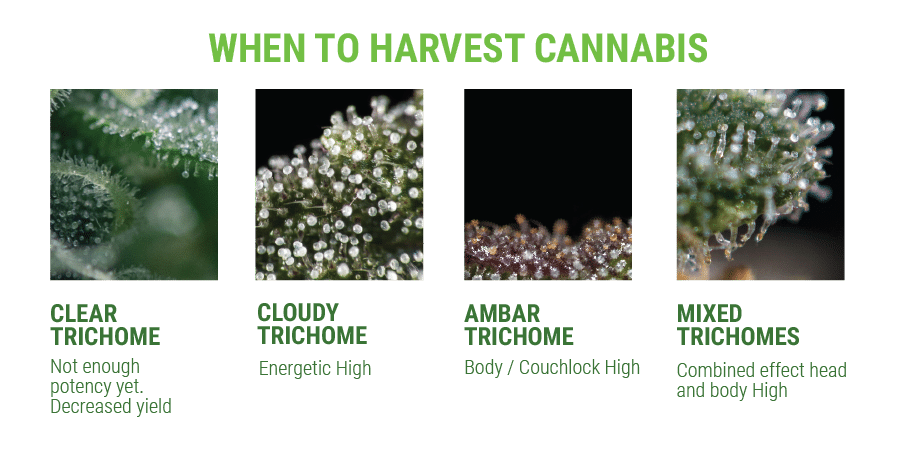
During the marijuana vegetative stage, trichome production starts but is minimal. They will appear white and clear when looking at them up close.
As the plants start the flowering stage, trichome production increases significantly. In the last two weeks the trichomes will start turning cloudy and milky white.
Trichomes happened to be one of the best indicators on when to harvest the plant. As the plant matures the trichomes start to become amber, dark red. Before you harvest make sure around 70%-80% of the trichomes are amber color.
Take a look at some trichome images and identifiers in the next section below.
Trichome Images, Close up, Under a Microscope
A trichome microscope experience will yield many images befitting of the cannabis plant. A surreal almost otherworldly look accessible only by means of vigilance and technology.
The trichome plant when seen beneath the microscope features frosted though nearly transparent bristles that could almost be compared to a pine tree after a dusting of snow.
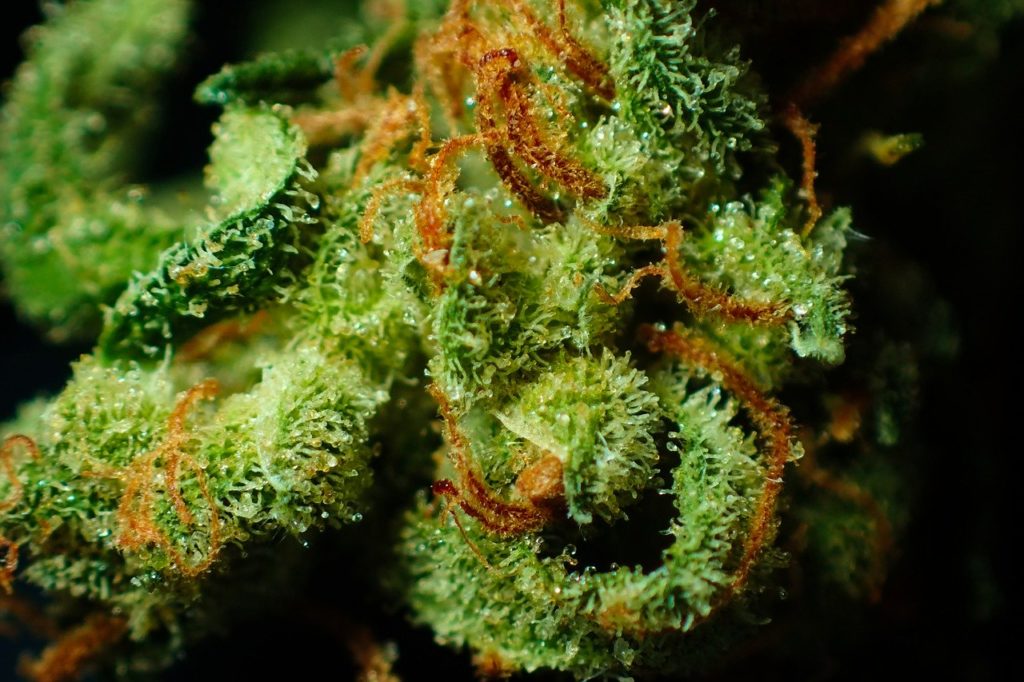
Terpenes
What are Terpenes?
Terpenes are aroma emitting phenols (any compound with a hydroxyl group linked directly to a benzene ring) that are made by every plant and even some insects.
A terpene is a minor cannabinoid, and consists of a repeating compound called isoprene, which contributes to the psychoactive effects of cannabis, and are instrumental in providing pain relief with many other medical benefits.
Like other cannabinoids, they bind to receptors in the brain to cause different psychological effects.
Are Terpenes legal?
Terpenes are found in a variety of plants, and are, in some cases legal as an extract.
However, when it comes to terpenes derived of the cannabis plant, the status is varies state to state. So are terpenes legal? As of right now, no. they are not legal on a federal level.
This is not based on anything against marijuana terpenes itself beside it being associated with the plant.
On its own, this element of cannabis meets most people’s standard of being harmless. However, due to its proximity to the marijuana plant, it still suffers a status that many find excessive or unnecessary.
In states that have legalized marijuana, cannabis terpenes are available to be use in a vary of beverage and food products.
As the cannabis plant continues to enjoy broader acceptance in the United States, access to these terpene is on the rise.
Types of Terpenes
The different types of terpenes are numerous when considered across nature. In the context of the cannabis family, they can be found both in the hemp and marijuana plant.
You’ll see in the terpene wheel chart illustrated below just how robust and diverse the flavor profile of this unique substance can be.
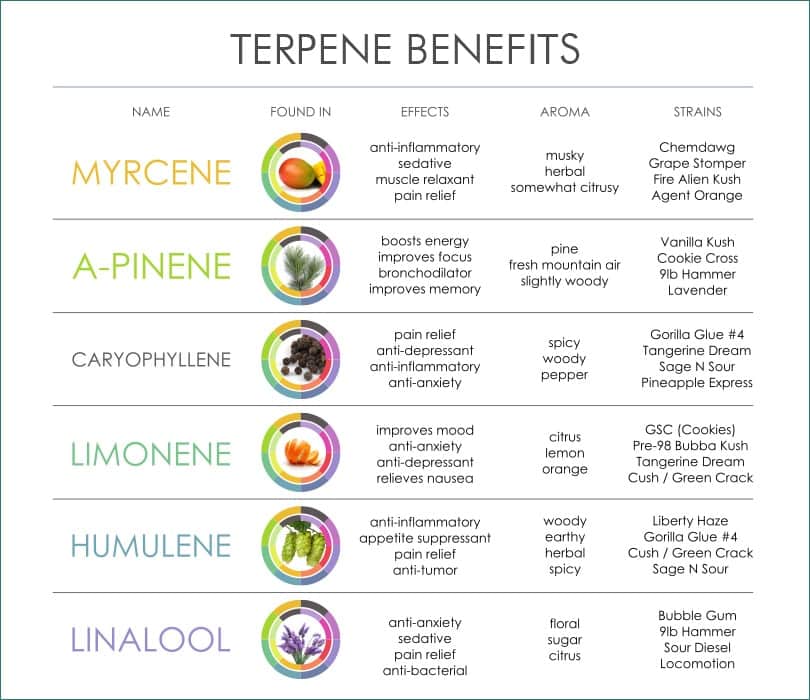
Terpinolene:
Terpinolene is a less common variety of terpene not because it is rarely seen but because it is rarely seen in large quantities. In terms of aroma and flavor profile, Terpinolene produces a mixed lot. It may contain elements of citrus, flora, or even pine.
Terpenoid:
Terpenoids are simply terpenes that feature multiple working groups. The term is often used interchangeably with “terpene” though in actuality there can be differences between the two. For example, A terpenoid may have been chemically altered to achieve its desired effect.
Limonene:
Limonene is a common element in all citrusy foods. In cannabis, it produces a similar zesty flavor.
Terpenes Wheel Chart
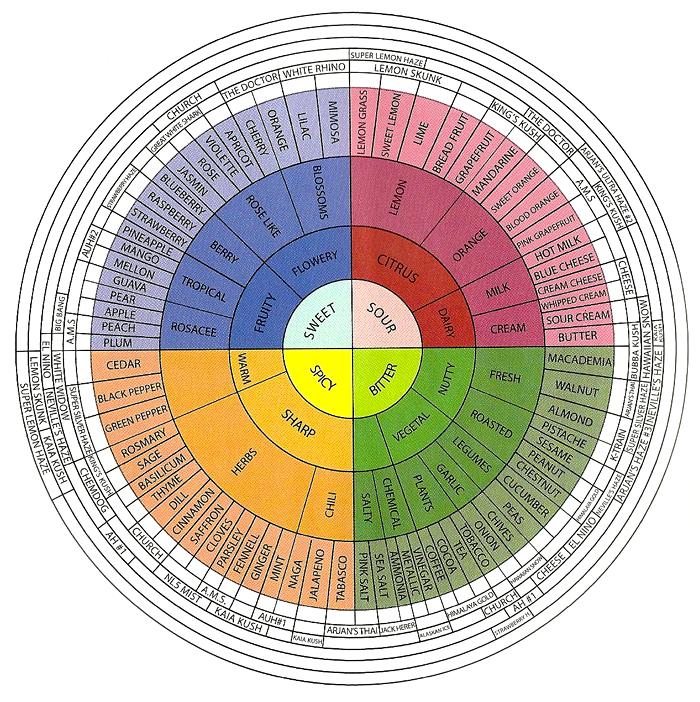
The aroma and flavors associated with terpenes can range radically from very sweet as is the case in pinene terpenes, or very bitter, as seen in limonene.
The colors in the Terpenes Wheel Chart are broken up by:
Blue – Sweet
Red – Sour
Yellow / Orange – Spicy
Green – Bitter
The terpenes profile will shape the overall terpenes flavor that they create.
Let’s talk a little bit more about the types of terpenes that exist.
Difference Between Terpenes and THC, CBD, CBN
The terpenes definition can get a little bit confusing when you compare it to that of other cannabis derivatives like CBD, CBN, THC, etc.
When you get right down to it the difference between the what separates terpenes from the other marijuana chemicals is simply in how they behave in the plant.
What makes terpenes a stand out chemical component of cannabis is that they are actually a ubiquitous element of flora in general.
You’ll find them in lavender, oranges, so on and so forth. It’s a versatile component of the plant with different impacts depending on where it is found.
CBD on the other hand, is more exclusive to the cannabis plant. At the end of the day, that’s the most interesting thing about the terps definition: it’s so subject to change depending on the context in which it is being applied.
Terpene Scents & Flavors
Terpenes give cannabis its many different types of scents and flavors, which can help the experienced consumer differentiate between strains.
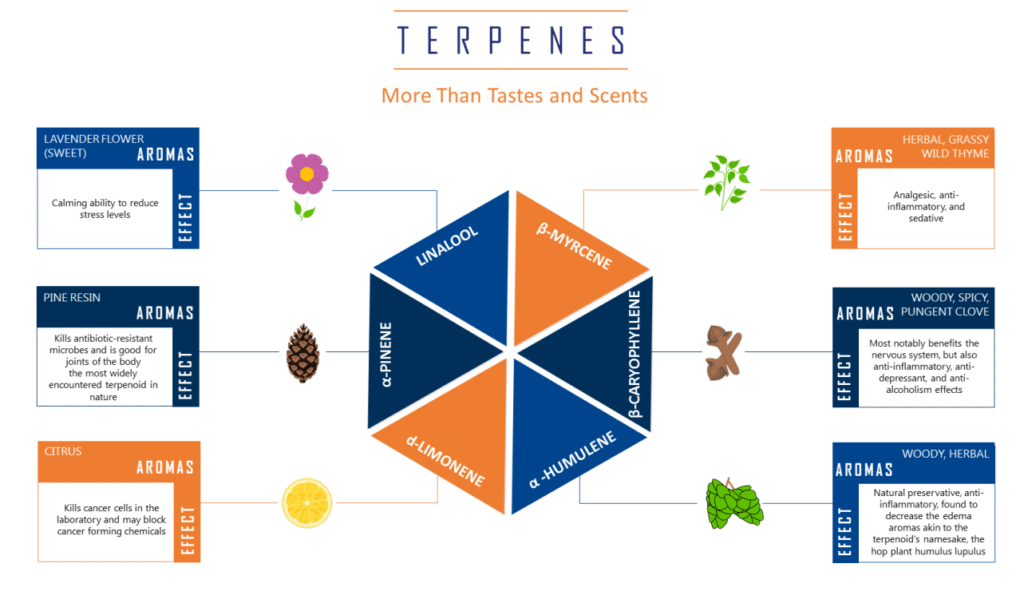
The really fun thing is that each terpene is going to be a little bit different. The various strains of cannabis make the plant extremely interesting and fun. There are lots of things that make white widow different from sour diesel, green crack different than OG kush. Potency, color, type of high just to name a few.
But they also each have their own unique scent and flavor. This is where the terpenes have their biggest impact on the plant. To put it another way, terpenes are what put the blueberries in blueberry kush.
You could dedicate an entire article to all of the unique different flavors found in the cannabis plant. We won’t go so far as that, but basically, if you can think of a unique flavor or scent that you encountered when interacting with a cannabis plant, terpenes probably had something to do with it.
Terpenes are organic hydrocarbons found in the essential oils of many plants, not just cannabis. With the rise of the legal cannabis industry, the discussion around terpenes has recently heated up, and terpenes from cannabis and other plants are being added to food, drinks, oils, lotions, and many other types of products.
How to Use Terpenes
Now you know what they are, but you don’t know how to use terpenes. That in mind, we will now take a look at some terpene effects and answer the question of what are terpenes used for.
Terpene uses
As an extract, terpenes are used for relaxation purposes. What the terpene actually does will depend on the specific chemical itself. In some cases, terpenes may increase the potency of a high. In other cases, it might promote a more mellow, relaxing sensation.
However, they can also be used for a variety of other purposes. Oil and aroma therapy, etc.
Unaltered in the cannabis flower, terpenes will behave in line with their nature. Many of these therapeutic benefits are given once the chemical reaches the terpene boiling point of 356 degrees.
That said, since people have figured out how to use terpenes, the application can vary substantially. We’ll touch on that a little bit later as we look at the different ways terpenes can be used.
Getting your hands on these things are another matter altogether. The terpenes store isn’t exactly down the street yet. Still, there are a variety of different manufacturers making great terpene infused products for states with the right legal status.
Terpene Infused Products
Terpene-infused products are growing quickly as the market increases for products that embody the taste, flavor, and smell of our favorite cannabis strains, with all of the benefits that terpenes add.
Here is a look at a few products that currently feature terpene infusion.
Cannabis Terpene Infused Wine

Cannavines, an infused marijuana wine, uses different terpenes to infuse their white and red wine options according to strength and body.
Carefully selected so as to enhance instead of overwhelm the flavors of the wine, Cannavines Red Blend is infused with terpenes from Headband, which is known for its hints of lemon and also its relaxing qualities and stress relief.
Their Chardonnay is a lighter and more airy wine combined with Sour Diesel, which is known for its earthy flavor and cerebral and energetic sensation. Terpenes are also now being added to non-alcoholic beverages, beers, and liquors.
Terpene Essential Oils
Because terpenes reduce pain, anxiety, and inflammation, they are widely sought after in many forms.
A terpene is basically the organic oil in your cannabis, so another way to add some of the same effects from cannabis to your life, without or in addition to consuming it, is essential oils.
However, not all essential oils contain terpenes. The most prominent terpenes in cannabis are present in many essential oils, and can be diffused and inhaled or absorbed through the skin with lotions.
Terpene-Infused Candles
It’s not all about topical creams and exotic drinks. You can also introduce your body to the wonders of terpenes through only the use of your nose. Terpene scented candles are a great way to engage in some cannabis-infused aromatherapy.
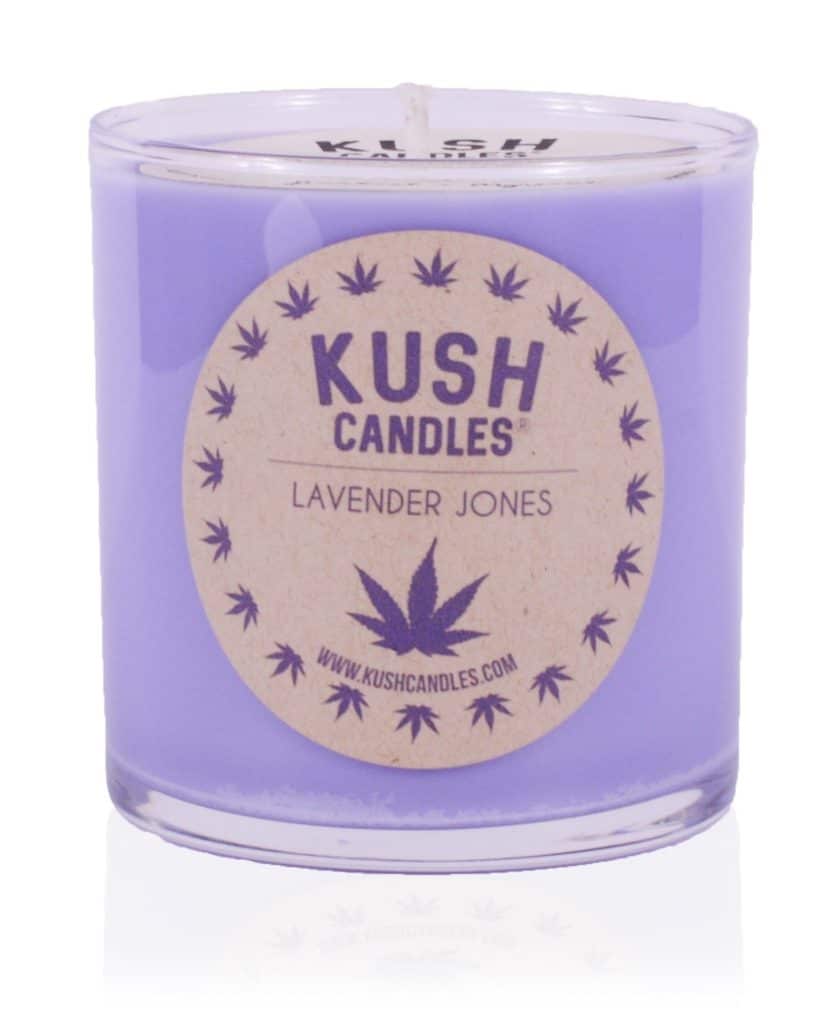
We sure have come a long way from the days where the scent of marijuana was associated only with skunk, huh?
At the end of the day, there are many ways to experience the benefits of terpenes without feeling “high”. They are a complicated element of the plant that has something to offer for everyone, whether you love marijuana or just a good candle.
- Psilocybin Mushrooms in Colorado | Is It Legal & Where You Can Get Some - April 20, 2024
- Weed Measurements Guide: Marijuana Quantities, Weights & Prices - July 1, 2023
- Moldy Weed | Risks, Identification, and Smoking Safety - June 24, 2023
